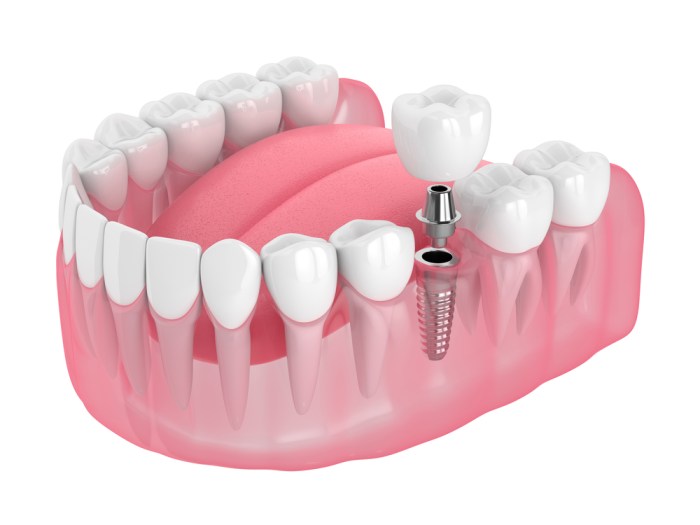How to get dental implants covered by medical insurance is a question many face. Securing coverage for this significant procedure often requires navigating complex insurance policies and demonstrating medical necessity. This guide provides a clear path, exploring the intricacies of dental insurance, the criteria for medical necessity, and the strategies for successful claim submissions. We’ll also cover alternative payment options and essential communication tips to help you achieve your dental health goals.
Understanding your dental insurance plan is the first crucial step. Different plans offer varying levels of coverage for preventative, basic, and major services, with dental implants often falling under the “major” category. Therefore, thoroughly reviewing your policy and understanding the specific exclusions is vital. Subsequently, we will delve into the process of demonstrating medical necessity, which is often the key to obtaining coverage for dental implants, even under plans that typically exclude them.
Understanding Dental Insurance Coverage

Dental insurance, while not identical to medical insurance, plays a crucial role in managing the costs associated with dental care. Understanding its structure and limitations is essential for maximizing its benefits and planning for potential out-of-pocket expenses. This section will break down the typical components of dental insurance plans to help you navigate the complexities of coverage.
Dental Insurance Plan Components
Most dental insurance plans share a common structure, generally including a network of dentists, annual maximums, deductibles, and co-insurance. The network specifies the dentists who have contracted with your insurance provider, often offering discounted rates. The annual maximum represents the total amount the plan will pay out in a year. Deductibles are the amount you must pay out-of-pocket before the insurance begins to cover expenses.
Co-insurance is the percentage of the remaining costs you are responsible for after meeting your deductible. For example, an 80/20 co-insurance plan means the insurance covers 80% and you cover 20%.
Categorization of Dental Services
Dental insurance plans typically categorize services into three tiers: preventative, basic, and major. Preventative services focus on maintaining oral health and preventing problems. Basic services address minor issues, while major services involve more extensive procedures.
Examples of Covered and Excluded Procedures
Preventative services, usually covered at 100% with minimal or no out-of-pocket costs, often include routine cleanings, examinations, and X-rays. Basic services, such as fillings and extractions, usually have a higher co-pay or co-insurance percentage. Major services, which frequently have the highest out-of-pocket costs, encompass procedures like crowns, bridges, dentures, and implants. However, coverage for major services is often subject to significant limitations and may require pre-authorization.
Many plans exclude cosmetic procedures like teeth whitening, unless medically necessary. Orthodontic treatment is also often a separate plan or has limited coverage under standard dental insurance.
Comparison of Coverage Levels Across Providers
The extent of coverage can vary significantly between insurance providers. The following table provides a simplified comparison – specific details are always subject to the individual plan’s terms and conditions. It is crucial to review your policy documentation for precise details.
| Provider | Annual Maximum | Preventative Coverage | Basic Coverage |
|---|---|---|---|
| Provider A | $1500 | 100% | 80% |
| Provider B | $1000 | 100% | 70% |
| Provider C | $2000 | 100% | 90% |
| Provider D | $1200 | 100% | 75% |
Determining Medical Necessity for Dental Implants

Securing dental implant coverage through medical insurance often hinges on establishing medical necessity. This means demonstrating that the implants are not solely for cosmetic improvement, but are required to address an underlying medical condition impacting your overall health and well-being. The process requires careful documentation and a clear understanding of what constitutes medical necessity in the eyes of your insurance provider.Medical necessity for dental implants is typically established when the missing teeth significantly impair a patient’s ability to eat, speak, or maintain overall oral health, leading to further health complications.
These complications can range from malnutrition and weight loss due to difficulty chewing, to temporomandibular joint (TMJ) disorders caused by improper bite alignment, and even increased risk of infection. Successfully demonstrating medical necessity often involves a collaborative effort between the patient, dentist, and potentially other medical specialists.
Medical Conditions Justifying Implant Coverage
Several medical conditions can justify the medical necessity of dental implants. These conditions often involve significant oral health issues that negatively impact a patient’s systemic health. For example, uncontrolled periodontal disease leading to significant bone loss, impacting the jaw structure and potentially spreading infection systemically, could justify implant coverage. Similarly, severe facial trauma resulting in significant tooth loss and impacting chewing and speech could also meet the criteria.
Other conditions might include severe oral cancer requiring reconstruction, or cases of cleft palate repair where implants are necessary for functional restoration. The key is to demonstrate a clear link between the missing teeth and a compromised state of overall health.
Required Documentation for Medical Necessity Claims
Supporting a medical necessity claim for dental implants requires comprehensive documentation. This typically includes a detailed referral from a medical doctor or specialist, outlining the patient’s medical history and how the missing teeth contribute to their overall health problems. The dentist’s comprehensive treatment plan, outlining the need for implants as opposed to alternative treatments, is also crucial. This plan should clearly articulate the connection between the proposed treatment and the improvement of the patient’s medical condition.
Detailed medical records, including radiographs (X-rays), photographs documenting the extent of bone loss or other oral health issues, and records of previous treatments attempted, are also essential. Finally, a detailed cost analysis comparing the cost of implants to alternative treatments should be included, demonstrating that implants represent the most medically appropriate and cost-effective solution.
Examples of Successful Medical Necessity Appeals
While specific details of successful appeals are often kept confidential due to patient privacy, general examples can illustrate the principles involved. One successful case might involve a patient with severe uncontrolled periodontal disease leading to significant bone loss and recurrent infections. The patient’s physician documented the systemic impact of the infection, linking it directly to the compromised oral health.
The dentist provided detailed records showing the extent of the bone loss and the inability to adequately treat the condition without implants. Another successful case might involve a patient who experienced severe facial trauma, resulting in significant tooth loss and impacting their ability to eat properly, leading to malnutrition. In this case, the physician documented the nutritional deficiencies, and the dentist demonstrated how implants would restore the patient’s ability to eat and improve their overall health.
In both scenarios, the comprehensive documentation clearly established the medical necessity of the implants.
Navigating the Insurance Claim Process

Submitting a claim for dental implant coverage can seem daunting, but understanding the process and gathering the necessary documentation beforehand can significantly increase your chances of successful reimbursement. This section Artikels the steps involved, provides a checklist of required documents, and explains how to appeal a denied claim. Remember that specific procedures and requirements vary between insurance providers, so always refer to your policy details and contact your insurer directly if you have any questions.The process generally involves several key steps, starting with pre-authorization (if required) and ending with claim submission and potential appeal.
Careful documentation and clear communication are essential throughout.
Claim Submission Steps
Submitting a dental implant claim typically requires a series of steps. First, ensure you’ve met all pre-authorization requirements. Next, gather all necessary documentation. Then, submit your claim using your insurer’s preferred method, whether it’s online, via mail, or through a dedicated claims portal. Finally, track the claim’s progress and follow up if necessary.
Failure to follow these steps could result in delays or denial of your claim.
Necessary Documents for Claim Submission
A complete claim submission typically requires several key documents. These documents help the insurance company verify the medical necessity of the procedure and determine the appropriate level of reimbursement. Missing documentation is a common reason for claim denials.
- Completed claim form: This form is usually provided by your insurance company and requires detailed information about the procedure, dates of service, and costs.
- Explanation of Benefits (EOB): This document from your dentist Artikels the services provided and the associated charges.
- Medical records: These records should document the medical necessity of the dental implants, including any relevant medical conditions or previous treatments. They may include radiographs, diagnostic tests, and consultation notes.
- Pre-authorization approval (if applicable): This document confirms your insurer’s pre-approval for the procedure.
- Dentist’s invoice: This invoice details the costs associated with the dental implant procedure.
The Appeals Process
If your initial claim is denied, you have the right to appeal the decision. Insurance companies have specific procedures for appeals, usually involving a written appeal letter supported by additional documentation. Thoroughly reviewing the denial letter to understand the reasons for the denial is crucial to crafting an effective appeal. Time limits for filing an appeal are typically stipulated in the insurance policy; missing the deadline can result in the denial becoming final.
Sample Appeal Letter
Below is a sample appeal letter. Remember to adapt this to your specific circumstances and include all relevant documentation.
To [Insurance Company Name],[Insurance Company Address]Subject: Appeal of Denied Claim – [Your Policy Number] – [Your Name]Dear [Insurance Claims Adjuster Name],This letter is to formally appeal the denial of my claim for dental implant coverage, claim number [Claim Number], dated [Date of Denial]. The denial letter cited [Reason for Denial given by the insurance company].However, I maintain that the dental implants were medically necessary due to [Clearly state the medical necessity, referencing specific medical conditions, such as severe bone loss, infection, or trauma, and supporting documentation]. My dentist, [Dentist’s Name], provided comprehensive documentation supporting this medical necessity, including [List supporting documentation, such as medical records, radiographs, and specialist consultation reports]. This documentation clearly demonstrates that the dental implants were not solely for cosmetic reasons but were essential for [State the essential outcome, e.g., restoring function, preventing further health issues].I respectfully request a review of my claim, considering the additional information provided. I have attached all relevant documentation to support my appeal. I can be reached at [Your Phone Number] or [Your Email Address] if you require any further clarification.Sincerely,[Your Name]
Exploring Alternative Payment Options: How To Get Dental Implants Covered By Medical Insurance

Securing dental implants can be a significant investment. While insurance may cover a portion of the costs, many individuals still face substantial out-of-pocket expenses. Fortunately, several alternative payment options can make dental implants more accessible and manageable. Understanding these options and their associated costs and benefits is crucial for making an informed decision.Exploring various financing plans and dental savings programs allows patients to budget effectively for their dental implant procedure.
This section details the different options, enabling you to choose the most suitable payment plan based on your individual financial circumstances.
Financing Plans
Many dental practices partner with financing companies to offer patients flexible payment plans. These plans typically involve spreading the total cost over a series of monthly installments, often with fixed interest rates or interest-free periods. The length of the payment plan, interest rates, and associated fees vary depending on the provider and the patient’s creditworthiness. For example, one common financing option might offer a 12-month interest-free plan, followed by a higher interest rate if the balance isn’t paid in full.
Another might offer a longer-term loan with a fixed monthly payment, but a higher overall interest charge.
Dental Savings Plans
Dental savings plans are membership-based programs that offer discounts on dental services, including implants. These plans usually involve an annual membership fee in exchange for reduced costs on various procedures. The specific discounts vary depending on the plan provider and the dental practice participating in the network. For instance, one plan might offer a 20% discount on all procedures, while another might offer specific discounts for particular treatments, such as implants.
It is important to carefully compare the annual membership fees against the potential savings on your anticipated implant procedure to determine the financial viability of such a plan.
Comparison of Payment Options
To illustrate the cost differences, let’s consider a hypothetical scenario. Assume the total cost of dental implants is $6,000.
- Out-of-Pocket Payment: The total cost is $6,000 paid upfront.
- Financing Plan (12-month interest-free): Monthly payments of $500, with no interest charges.
- Financing Plan (36-month loan with 5% interest): Monthly payments would be approximately $180, but the total cost paid would exceed $6,000 due to the interest.
- Dental Savings Plan (20% discount): The cost after the discount would be $4,800. This needs to be weighed against the annual membership fee of the savings plan itself.
Calculating Total Cost
Calculating the total cost of dental implants requires considering several factors. The base cost of the procedure is the starting point. This needs to be added to any additional fees such as:
- Diagnostic tests and X-rays
- Bone grafting (if required)
- Sinus lift (if required)
- Crowns or abutments
- Financing fees or interest charges
- Dental savings plan membership fees (if applicable)
Total Cost = Base Cost of Implants + Additional Procedure Costs + Financing Fees + Savings Plan Fees
For example, if the base cost is $4,000, bone grafting costs $1,000, crowns cost $500, and a financing plan adds $500 in interest, the total cost would be $6,000.
Communicating with Your Dentist and Insurance Provider

Effective communication is crucial for successfully navigating the process of obtaining dental implant coverage. Open and honest dialogue with both your dentist and your insurance provider can significantly increase your chances of approval and minimize potential misunderstandings. Clear communication ensures everyone is on the same page regarding treatment plans, costs, and insurance benefits.
Tips for Effective Communication with Your Dentist
Maintaining open communication with your dentist is essential throughout the entire process. This includes proactively discussing your insurance coverage early on, ensuring they understand your financial constraints, and asking clarifying questions about treatment options and their associated costs. This collaborative approach fosters a better understanding and facilitates a smoother path towards obtaining the necessary approvals.
Questions to Ask Your Dentist and Insurance Provider
Asking the right questions is paramount. For your dentist, inquire about treatment options, the estimated cost of each, and the likelihood of insurance coverage for each procedure. For your insurance provider, confirm your coverage specifics, including the process for pre-authorization, what documentation is required, and what portion of the cost will be covered. Examples include: “What is the total estimated cost of the implant procedure?”, “What are my specific benefits for dental implants?”, and “What documentation do I need to submit for pre-authorization?”.
Importance of Obtaining Pre-Authorization for Dental Implants
Pre-authorization is a crucial step. It involves obtaining your insurance company’s approval for the proposed treatmentbefore* the procedure begins. This approval confirms coverage and helps avoid unexpected out-of-pocket expenses. Failure to obtain pre-authorization may result in a significant portion of the cost being your responsibility. It also ensures that your treatment plan aligns with your insurance policy’s requirements.
Sample Conversation Script: Patient and Insurance Provider, How to get dental implants covered by medical insurance
The following is an example of a conversation between a patient and their insurance provider: Patient: “Hello, I’m calling to inquire about coverage for dental implants. My dentist has recommended the procedure, and I have a pre-authorization form here.” Insurance Provider: “Certainly. Could you please provide your policy number and the dentist’s information?” Patient: “(Provides information)” Insurance Provider: “Thank you. Let me review your policy and the pre-authorization form.
It appears your policy covers a percentage of the procedure, but certain conditions must be met. Specifically, it requires documentation showing the medical necessity of the implants.” Patient: “My dentist has provided a letter explaining the medical necessity. Is there anything else I need to provide?” Insurance Provider: “Please ensure all necessary forms are completed and submitted. We will review your request and notify you of our decision within [number] business days.” Patient: “Thank you for your assistance.”
Illustrating the Implant Procedure

Dental implant placement is a multi-stage process requiring precision and careful planning. The procedure aims to replace missing teeth with artificial roots that integrate with the jawbone, providing a stable foundation for permanent crowns or dentures. The success of the procedure depends heavily on proper planning, execution, and post-operative care.
Stages of the Dental Implant Procedure
The dental implant procedure typically involves several distinct phases. First, a thorough examination and assessment are conducted to determine the patient’s suitability for implants and to plan the placement strategy. This may include X-rays and 3D imaging to assess bone density and jaw structure. Subsequent stages involve surgical placement of the implant, a period of osseointegration (bone healing), and finally, the placement of the abutment and restoration (crown).
The timeline for each phase varies depending on individual factors.
Bone Grafting
Bone grafting is often necessary when insufficient bone density exists to support the implant. This procedure involves adding bone material to the jawbone to increase its volume and density. The purpose of bone grafting is to create a stable foundation for the implant, enhancing its long-term stability and success rate. The procedure itself may involve using the patient’s own bone (autograft), bone from a donor (allograft), or synthetic bone substitutes (xenograft or alloplast).
The grafted bone is carefully placed and secured to promote integration with the existing bone. The healing time for bone grafting can vary, typically ranging from several months to a year, before the implant can be placed.
Types of Dental Implants
Various types of dental implants are available, each with its own advantages and disadvantages. Endosteal implants, the most common type, are surgically placed into the jawbone. Subperiosteal implants are placed on top of the jawbone, suitable for patients with insufficient bone height. Zygomatic implants are used for patients with significant bone loss in the upper jaw, anchoring into the cheekbone.
The choice of implant type depends on factors such as bone density, jaw structure, and the patient’s overall health. For instance, a patient with significant bone loss might be a candidate for zygomatic implants, while a patient with adequate bone density might be suitable for endosteal implants.
Post-Operative Care
Post-operative care is crucial for the success of dental implant placement. The patient is usually given specific instructions to follow, including maintaining good oral hygiene, using prescribed medications (pain relievers and antibiotics), and avoiding certain foods and activities that could interfere with healing. Regular follow-up appointments with the dentist are essential to monitor the healing process and address any potential complications.
Patients are typically advised to avoid smoking, which can impede healing and increase the risk of implant failure. Careful adherence to the post-operative instructions is vital for ensuring successful integration of the implant and achieving optimal long-term results.
Final Thoughts

Successfully navigating the process of obtaining medical insurance coverage for dental implants requires a proactive approach. By understanding your insurance policy, demonstrating medical necessity effectively, and maintaining open communication with your dentist and insurance provider, you can significantly increase your chances of approval. Remember to explore alternative payment options if full coverage isn’t secured, ensuring that you can access the dental care you need.
This guide provides a comprehensive framework to empower you in this journey towards a healthier, more confident smile.